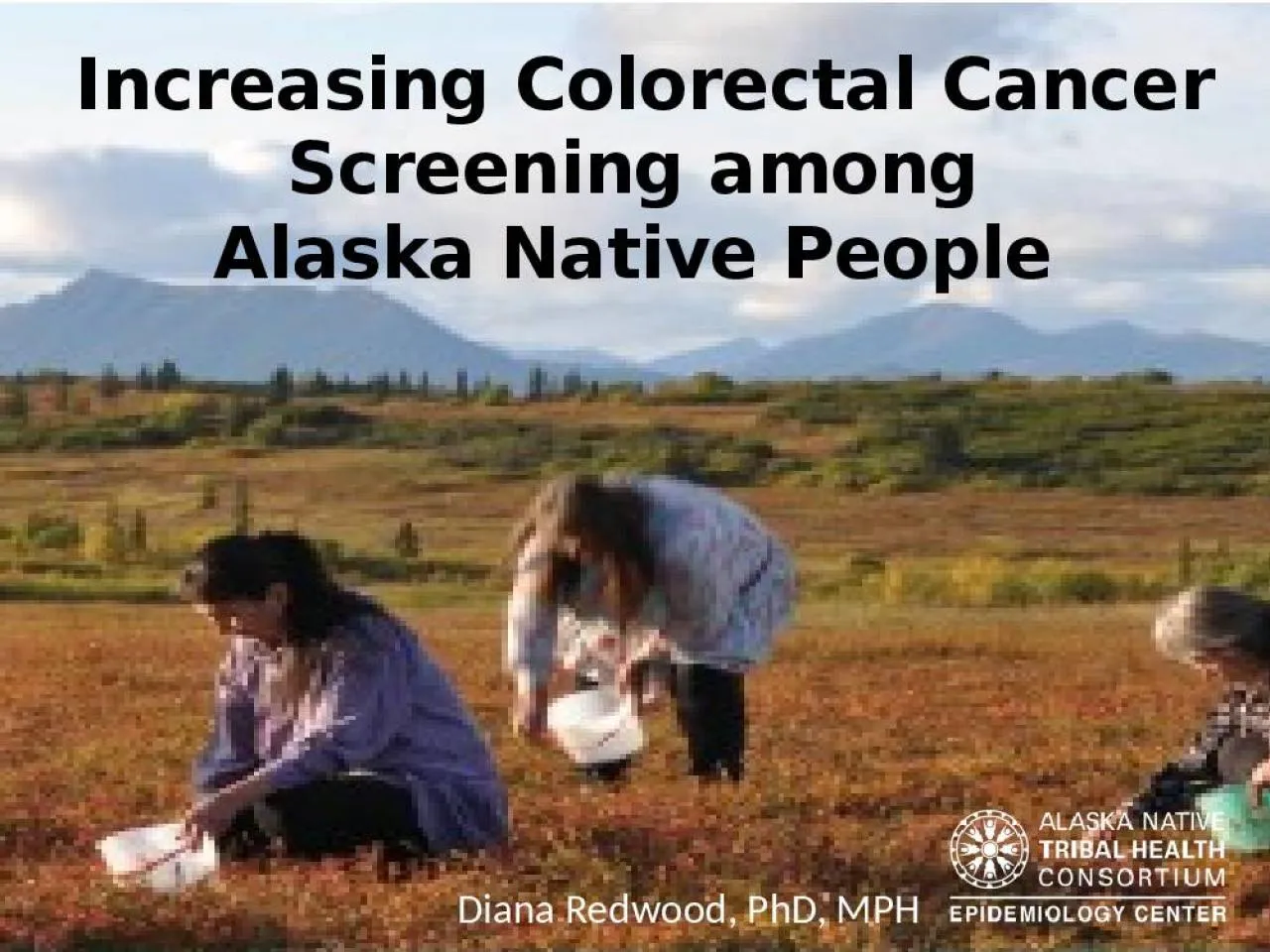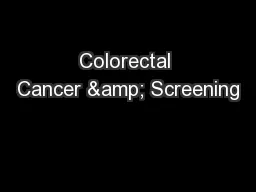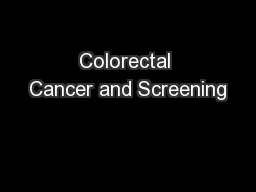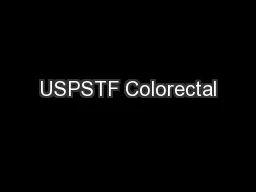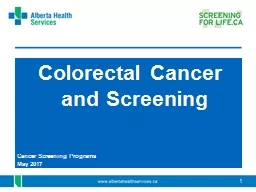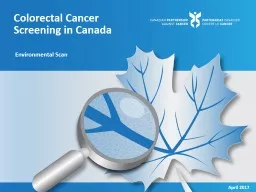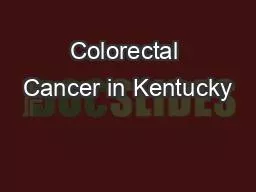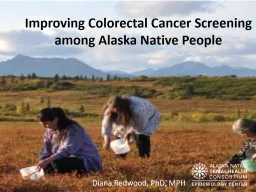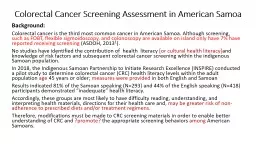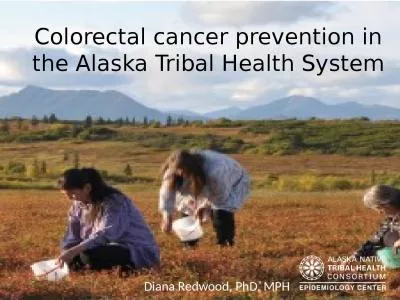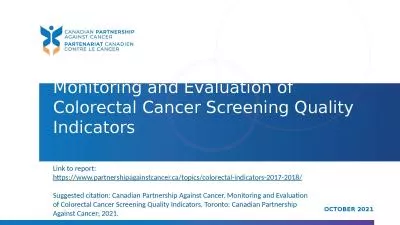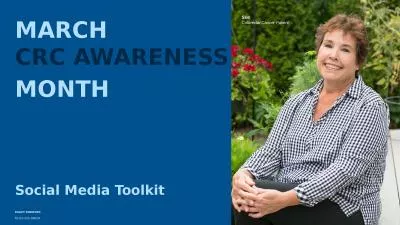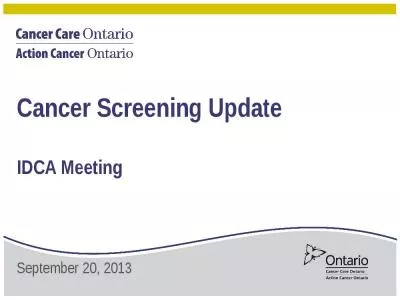PPT-Increasing Colorectal Cancer Screening among
Author : deborah | Published Date : 2022-05-15
Alaska Native People Diana Redwood PhD MPH Land Acknowledgement Thank you to the Denaina people on whose traditional lands I live Thanks for their past and
Presentation Embed Code
Download Presentation
Download Presentation The PPT/PDF document "Increasing Colorectal Cancer Screening ..." is the property of its rightful owner. Permission is granted to download and print the materials on this website for personal, non-commercial use only, and to display it on your personal computer provided you do not modify the materials and that you retain all copyright notices contained in the materials. By downloading content from our website, you accept the terms of this agreement.
Increasing Colorectal Cancer Screening among: Transcript
Alaska Native People Diana Redwood PhD MPH Land Acknowledgement Thank you to the Denaina people on whose traditional lands I live Thanks for their past and present stewardship of the waters plants animals and spiritual practices of this place. brPage 2br Screening Saves Lives brPage 3br What is colorectal cancer Colon and Rectum Both men and women are at risk for colorectal cancer Screening tests can 64257nd polyps so they can be removed before they turn into cancer Screening Saves Lives Sept . 2013. Sometimes there are things that may be hard to talk about…. But not talking about them is even harder. What is Colorectal Cancer?. Cancer that develops on the inner wall of the colon and rectum (large bowel or large intestine). Cancer Screening Programs . September 2013. How much do you know about colorectal cancer?. How common is colorectal cancer in Alberta? (i.e. 1 in X men and 1 in X women)?. How many cases of colorectal cancer can be treated successfully if found early (i.e. X out of 10)?. C. ancer Screening Guidelines: What’s New?. Appathurai Balamurugan, MD, . DrPH, MPH. State Chronic Disease Director. Medical Director/Associate Director for Science. Chronic Disease Branch/Center for Health Advancement. Cancer Screening Programs . May 2017. How much do you know about colorectal cancer?. How common is colorectal cancer in Alberta? (i.e. 1 in X men and 1 in X women)?. How many cases of colorectal cancer can be treated successfully if found early (i.e. X out of 10)?. in . Canada . Environmental . Scan. 1. Background. The Canadian Partnership Against Cancer collects information annually on . national, provincial . and territorial . colorectal . cancer screening guidelines, . Trends and Geographic Variation. 2000 - 2008. Presented by. Thomas C. Tucker, PhD, MPH. Associate Professor. Department of Epidemiology . College of Public Health. University of Kentucky. and. Senior Director for Cancer Surveillance. Diana Redwood, PhD, MPH. Why is CRC Screening Important?. Photo . Source: www.medicalinfo-y3n.blogspot.com. 3. More than 95% of Colorectal Cancers Follow Adenoma-Carcinoma Sequence. Normal Colon. Colon Cancer. Background:. Colorectal cancer is the third most common cancer in American Samoa. Although screening, such as FOBT, flexible sigmoidoscopy, and colonoscopy are available on island only have 7% have reported receiving screening.. Index of Select Slides Colorectal Cancer Overview Colorectal Cancer Screening Colorectal Cancer Screening Prevalence Colorectal Cancer Screening in Texas Overview of Colorectal Cancer Incidence Overvi Tribal Health . System. Diana Redwood, PhD, MPH. Disclosures. CDC and NIH funding. Exact Sciences Investigator Award. Land Acknowledgement. Thank you to the . Dena’ina. . people, on whose traditional lands I live. Thanks for . Link to report: . https://www.partnershipagainstcancer.ca/topics/colorectal-indicators-2017-2018/. . Suggested citation: Canadian Partnership Against Cancer. Monitoring and Evaluation of Colorectal Cancer Screening Quality Indicators. Toronto: Canadian Partnership Against Cancer; 2021.. MARCH . CRC AWARENESS . MONTH. . Social Media Toolkit. M-US-CG-04629. 2. How to use the toolkit. Each copy and post can be used on social platforms such as LinkedIn, Facebook, and Instagram to promote CRC Awareness . 1. Cancer Screening Update IDCA MeetingSeptember 20, 20132. OverviewOntario’s Cancer Screening ProgramsOntario Breast Screening Program (OBSP)CR Mammography Technology Transition Project23. Ontario’s Cancer Screening ProgramsOntario Breast...
Download Document
Here is the link to download the presentation.
"Increasing Colorectal Cancer Screening among"The content belongs to its owner. You may download and print it for personal use, without modification, and keep all copyright notices. By downloading, you agree to these terms.
Related Documents

